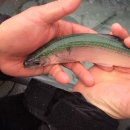Brook trout are either extirpated or greatly reduced in many rivers and streams throughout the eastern United States. We assessed genetic diversity in brook trout populations in northwestern Pennsylvania and western New York. As expected, we found diversity correlated to habitat connectivity between populations, and population isolation. We also evaluated and found no gene introgression with hatchery fish stocked over 20 years ago. This research is informing Pennsylvania Fish and Boat Commission and New York State Department of Environmental Conservation decisions on restoring habitat for brook trout, including prioritizing barriers to remove or replace. We also are conducting annual brook trout population assessments on several streams to understand long-term trends, and how these trends are influenced by abundance of brook trout, streamflow, water quality, and temperature, and co-occurrence of non-native trout species.
Fisheries management, Monitoring, Research





